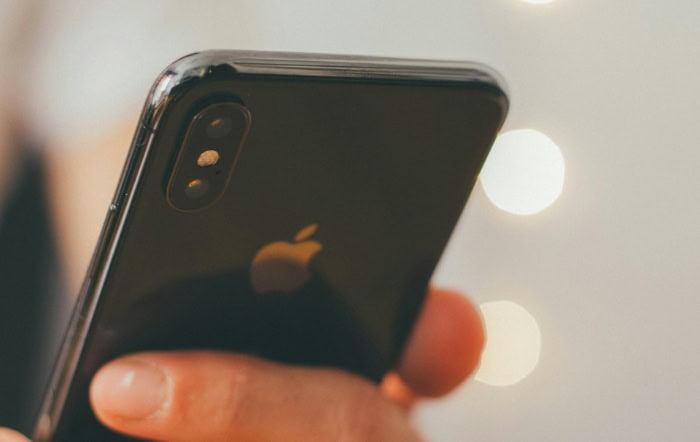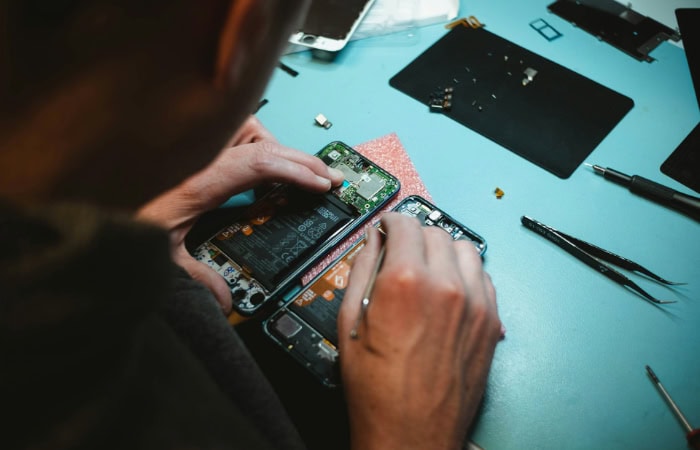White Spots on Phone Screen: Fixes You Can Try Today

White spots on your phone screen can be a frustrating and concerning issue. These unexpected blemishes disrupt your viewing experience and may signal underlying problems with your device.
From tiny dots to larger patches, white spots come in various forms and can stem from different causes. Addressing this problem promptly is crucial to prevent further damage and maintain your phone's functionality.
Understanding White Spots on Phone Screens
White spots on phone screens can manifest in various forms and stem from different causes. These visual anomalies can significantly impact your device's display quality and user experience.
By familiarizing yourself with the types of white spots and their common causes, you'll be better equipped to address the issue effectively.
Types of White Spots
Phone screens can display white spots in several distinct ways. The most common type is single dots, which appear as small, isolated white spots scattered across the screen or concentrated in a particular area.
These often result from stuck pixels or minor manufacturing defects. Another form is patches, which are larger white areas covering multiple pixels or sections of the screen.
These patches can be irregular in shape and may indicate more severe issues such as pressure damage or backlight problems. Lastly, white lines can run horizontally, vertically, or diagonally across the screen.
These lines can be caused by various factors, including manufacturing defects or damage to the display's internal components.
Common Causes of White Spots
Several factors can lead to the appearance of white spots on your phone screen. Pressure damage is a frequent culprit, occurring when excessive force is applied to the screen.
This often happens when a phone is kept in a tight pocket, sat on, or subjected to impact. The pressure can damage the liquid crystal display (LCD) or organic light-emitting diode (OLED) panel, resulting in visible white areas.
Stuck pixels represent another common cause. Individual pixels on the screen can sometimes become “stuck” in a particular color state, often white.
This issue is more prevalent in LCD screens and can be caused by manufacturing defects or electrical malfunctions within the display.
For phones with LCD screens, backlight issues can also lead to white spots. The backlight illuminates the display, and if certain areas malfunction or become damaged, it can result in white spots or uneven illumination across the screen.
Lastly, manufacturing defects can cause white spots to appear on your phone screen. These flaws may be present from the moment you first use your device, though they might not be immediately noticeable.
Over time, these defects can become more apparent, manifesting as white spots on the display.
Diagnosing the Problem

Accurately diagnosing the cause of white spots on your phone screen is crucial for determining the most effective solution. This process involves careful observation and analysis of the screen's appearance under various conditions.
Identifying Stuck Pixels
Stuck pixels appear as small, bright dots that remain consistently white regardless of the image displayed on the screen. To identify stuck pixels, display a solid black image on your phone screen and examine it closely in a dark room.
Stuck pixels will stand out as bright white dots against the dark background. It's important to note that stuck pixels maintain their white color and do not change or flicker.
Recognizing Pressure Damage
Pressure damage often results in larger, irregularly shaped white areas on the screen. These spots may appear blurry or have a slightly different texture compared to the surrounding screen area.
To identify pressure damage, gently flex your phone (if it's not a rigid device) and observe if the white spots change shape or intensity. Pressure damage is often accompanied by visible cracks or indentations on the screen's surface.
Distinguishing Backlight Problems
Backlight issues typically manifest as uneven illumination across the screen or as bright spots that are more noticeable when viewing dark content. To diagnose backlight problems, display a solid gray image on your screen and view it in a dimly lit room.
Look for areas that appear brighter or have a different hue compared to the rest of the screen. Backlight issues may also cause the affected areas to appear more prominent when you change the viewing angle of the screen.
Assessing Potential Moisture Damage
Moisture damage can cause white spots that often have a cloudy or foggy appearance. These spots may change in size or intensity over time as the moisture evaporates or spreads.
To assess moisture damage, check for any signs of water ingress around the edges of the screen or near the phone's ports. Look for a small moisture indicator (usually a small white sticker that turns red when exposed to water) inside the SIM card tray or battery compartment, if accessible.
When diagnosing white spots on your phone screen, it's important to consider the device's history. Think about any recent incidents that might have exposed your phone to excessive pressure, moisture, or extreme temperatures.
This information, combined with your visual observations, can help pinpoint the most likely cause of the white spots and guide you towards the appropriate solution.
DIY Solutions for White Spots
Before seeking professional help, you can try several do-it-yourself solutions to address white spots on your phone screen. These methods are generally safe and can be effective for certain types of screen issues.
However, it's important to proceed with caution and stop immediately if you encounter any resistance or if the problem worsens.
Using Pixel-Fixing Apps for Stuck Pixels
Pixel-fixing apps can be an effective solution for stuck pixels. These apps work by rapidly cycling through different colors on your screen, which can sometimes “unstick” the problematic pixels.
To use a pixel-fixing app, first download a reputable one from your device's app store. Run the app for at least 30 minutes, allowing it to cycle through various colors and patterns.
Some apps may require you to locate and tap on the stuck pixel manually. It's worth noting that this method may need to be repeated several times for best results.
Gently Massaging the Screen for Pressure Spots
For white spots caused by pressure damage, a gentle massage technique might help. First, turn off your phone and remove any screen protector.
Using a soft microfiber cloth, apply gentle pressure in a circular motion over the affected area. Be extremely careful not to press too hard, as this could exacerbate the problem.
Continue this process for about a minute, then turn on your phone to check if the white spot has improved. If not, you can repeat the process a few times, but avoid overdoing it to prevent further damage.
Cleaning Techniques for Dirt and Smudges
Sometimes, what appears to be a white spot might simply be a stubborn smudge or dirt particle. To clean your screen effectively, start by powering off your device.
Use a slightly damp microfiber cloth to gently wipe the screen in a circular motion. For tougher spots, you can use a small amount of distilled water or a specialized screen cleaning solution.
Avoid using harsh chemicals or abrasive materials, as these can damage the screen's coating. After cleaning, use a dry part of the cloth to remove any remaining moisture.
Addressing External Pressure Issues
If your phone is experiencing ongoing pressure that's causing white spots, it's crucial to identify and eliminate the source. Check your phone case to ensure it's not too tight or applying uneven pressure on the screen.
If you carry your phone in a pocket, consider using a different pocket or a phone holster to reduce pressure. For phones with flexible screens, avoid storing them in positions that cause bending or twisting.
By removing these external pressure sources, you may prevent the white spots from worsening and potentially allow existing spots to recover over time.
When to Seek Professional Help

While DIY solutions can be effective for minor screen issues, there are situations where professional assistance becomes necessary. Recognizing when to seek expert help can save you time, prevent further damage to your device, and ensure a proper repair.
Signs That Indicate a Need for Expert Assistance
Several indicators suggest that your phone's white spot issue requires professional attention. If the white spots are expanding or multiplying, it's a clear sign that the problem is worsening and needs expert evaluation.
Similarly, if the spots are accompanied by other display issues such as flickering, dead pixels, or color distortions, these complex symptoms often require specialized tools and knowledge to address.
Another crucial indicator is the persistence of white spots after attempting DIY solutions. If you've tried the recommended at-home fixes without success, it's time to consult a professional.
Additionally, if your phone has suffered significant physical damage, such as a cracked screen or water damage alongside the white spots, professional repair is almost always necessary.
Lastly, if your device is still under warranty, it's advisable to seek assistance from the manufacturer or an authorized service provider to avoid voiding your warranty with DIY attempts.
Types of Repairs Professionals Can Perform
Professional technicians have access to specialized tools and parts that allow them to perform a wide range of repairs for white spot issues. One common repair is screen replacement, which involves swapping out the entire display assembly.
This is often the solution for extensive pressure damage or widespread pixel issues.
For backlight problems, professionals can replace the backlight unit or repair damaged components within the display. In cases of moisture damage, technicians can open the device, dry internal components, and replace any corroded parts.
Some repair shops offer advanced pixel repair services using specialized equipment that can fix stuck pixels without replacing the entire screen. This can be a more cost-effective option for isolated pixel issues.
Costs Associated with Professional Repairs
The cost of professional repairs for white spots can vary widely depending on several factors. The type of repair needed, the model of your phone, and your location all play a role in determining the final price.
Screen replacements are often the most expensive option, with costs ranging from $100 to $300 for budget and mid-range phones, and potentially exceeding $500 for high-end or newer models. Backlight repairs typically fall in the $100 to $200 range, while specialized pixel repair services might cost between $50 and $150.
It's important to note that authorized service centers from manufacturers like Apple or Samsung may charge more than independent repair shops. However, they offer the advantage of using genuine parts and maintaining your warranty.
Before committing to a repair, it's advisable to get quotes from multiple reputable repair shops. Some technicians offer free diagnostics, which can help you understand the extent of the problem and the most cost-effective solution.
Additionally, check if your phone is covered by insurance or an extended warranty, as this could significantly reduce or eliminate your out-of-pocket expenses for the repair.
Preventing White Spots on Phone Screens
Prevention is always better than cure, especially when it comes to maintaining your phone's screen. By adopting proper handling techniques, using protective accessories, avoiding extreme conditions, and performing regular maintenance, you can significantly reduce the risk of white spots appearing on your phone screen.
Proper Handling and Storage Techniques
The way you handle and store your phone plays a crucial role in preventing screen damage. Always hold your phone with a firm but gentle grip to avoid applying excessive pressure to the screen.
When placing your phone down, set it screen-side up on a flat, clean surface to minimize the risk of scratches or pressure points.
Avoid storing your phone in tight pockets or cramped spaces where it might be subjected to bending or compression. Instead, use a dedicated phone pocket in your bag or a separate carrying case.
If you must put your phone in your pocket, ensure it's not in a position where you might accidentally sit or lean on it.
When not in use, store your phone in a cool, dry place away from direct sunlight. This helps prevent heat damage and reduces the risk of moisture accumulation, both of which can contribute to screen issues.
Using Protective Cases and Screen Protectors
Investing in a high-quality protective case and screen protector can significantly reduce the risk of white spots and other screen damage. Choose a case that provides adequate protection without putting pressure on the screen edges.
Look for cases with raised bezels that keep the screen from directly contacting surfaces when placed face-down.
Screen protectors add an extra layer of defense against scratches and minor impacts. Tempered glass protectors are particularly effective, as they can absorb and distribute pressure that might otherwise damage the screen.
When applying a screen protector, follow the instructions carefully to avoid trapping air bubbles or dust particles that could create pressure points.
Avoiding Exposure to Extreme Conditions
Extreme temperatures and humidity can wreak havoc on your phone's display. Avoid leaving your phone in direct sunlight or in a hot car, as excessive heat can damage the screen's internal components.
Similarly, extremely cold temperatures can cause the display to malfunction or develop white spots.
Protect your phone from moisture by keeping it away from water sources and using it with dry hands. If you're in a humid environment, consider using moisture-absorbing silica gel packets in your phone's storage area.
Rapid temperature changes can also cause condensation inside your phone, potentially leading to white spots. Allow your phone to gradually adjust to new temperatures, especially when moving from cold to warm environments.
Regular Maintenance Tips
Regular maintenance can help you spot potential issues early and keep your phone's screen in top condition. Clean your screen gently but regularly using a soft, lint-free cloth.
For stubborn smudges, lightly dampen the cloth with distilled water or a specialized screen cleaning solution. Avoid using harsh chemicals or abrasive materials that could damage the screen's coating.
Periodically check your phone case and screen protector for signs of wear or damage. Replace them as needed to ensure continued protection.
If you notice any small scratches or imperfections on your screen, address them promptly to prevent them from worsening or creating weak points where white spots could develop.
Lastly, keep your phone's software up to date. Manufacturers often release updates that can improve display performance and resolve known issues that might contribute to screen problems.


